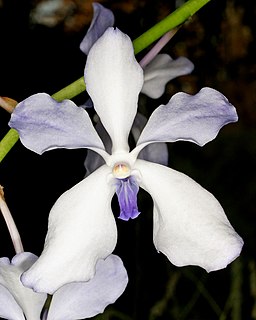
Vanda, abbreviated in the horticultural trade as V., is a genus in the orchid family, Orchidaceae. There are about 80 species, and the genus is commonly cultivated for the marketplace. This genus and its allies are considered to be among the most specifically adapted of all orchids within the Orchidaceae. The genus is highly prized in horticulture for its showy, fragrant, long-lasting, and intensely colorful flowers. Vanda species are widespread across East Asia, Southeast Asia, and New Guinea, with a few species extending into Queensland and some of the islands of the western Pacific.
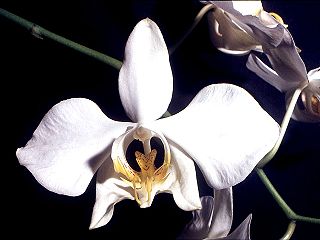
PhalaenopsisBlume (1825), commonly known as moth orchids, is a genus of about seventy species of plants in the family Orchidaceae. Orchids in this genus are monopodial epiphytes or lithophytes with long, coarse roots, short, leafy stems and long-lasting, flat flowers arranged in a flowering stem that often branches near the end. Orchids in this genus are native to India, Taiwan, China, Southeast Asia, New Guinea and Australia with the majority in Indonesia and the Philippines.
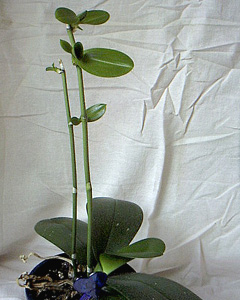
In horticulture, a keiki is a plant produced asexually by an orchid plant, especially Dendrobium, Epidendrum, and Phalaenopsis orchids. The baby plant is an exact clone of the mother plant, sometimes flowering while still attached to the mother. The word keiki is Hawaiian for "baby" or "child", literally "the little one".

Thomas Lobb (1817–1894) was a British botanist and, along with his older brother, William Lobb, collected plants for the plant nursery Veitch.

The ornamental orchid species Phalaenopsis hieroglyphica is native to certain islands of the Philippines. Its flowers are creamy white with transverse markings that resemble glyphs. Through hybridization, growers have successfully created flowers with different shapes and colors while retaining the glyphs. Since 1975, the species has been protected under Appendix II of the Convention on International Trade in Endangered Species of Wild Fauna and Flora (CITES).

Phalaenopsis amabilis, commonly known as the moon orchid or moth orchid in India and as anggrek bulan in Indonesia, is a species of flowering plant in the orchid family Orchidaceae, native to the East Indies and Australia, and widely cultivated as a decorative houseplant. It is an epiphytic or lithophytic herb with long, thick roots, between two and eight thick, fleshy leaves with their bases hiding the stem and nearly flat, white, long-lasting flowers on a branching flowering stem with up to ten flowers on each branch.
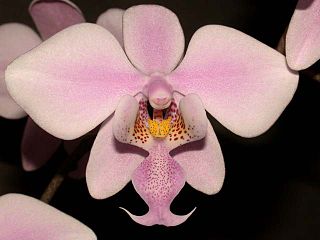
Phalaenopsis schilleriana is a plant of the orchid genus Phalaenopsis and an endemic species to Philippines. It has lilac flowers.

Phalaenopsis equestris is a flowering plant of the orchid genus Phalaenopsis and native to Philippines and Taiwan. The inflorescence has 10 to 20 flowers of about 25 mm (1 in) diameter.
David Burke was one of the most widely travelled plant collectors, who was sent by James Veitch & Sons to collect plants in British Guiana, Burma and Colombia. In his later life, Burke became rather eccentric, preferring the privations of life away from his native England.

Phalaenopsis aphrodite is a species of orchid found from southeastern Taiwan to the Philippines.

Phalaenopsis bellina is a species of orchid endemic to Borneo. It is one of about 60 species the genus Phalaenopsis. Today it is one of the most commonly cultivated species in the genus.

Phalaenopsis gigantea is named for the giant size of its leaves, which can grown over 2 feet in length on a mature plant. This orchid is endemic to Borneo and was first described in 1909. It is the largest known Phalaenopsis species.

Phalaenopsis lueddemanniana is a species of orchid endemic to the Philippines.
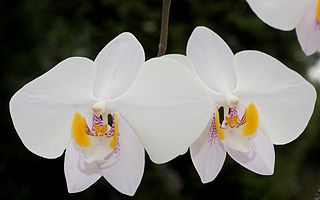
Phalaenopsis philippinensis is an endemic species of orchid found from Luzon island in the Philippines.

Phalaenopsis stuartiana is a species of orchid endemic to the island of Mindanao, in the Philippines.

Phalaenopsis sumatrana is a species of orchid endemic to peninsular Thailand, Vietnam and southern Sumatra.

Vanda sanderiana is a flower of the orchid family. It is commonly called Waling-waling in the Philippines and is also called Sander's Vanda, after Henry Frederick Conrad Sander, a noted orchidologist. The orchid is considered to be the "Queen of Philippine flowers" and is worshiped as a diwata by the indigenous Bagobo people.

Phalaenopsis bastianii is a species of orchid endemic to the Philippines. Similar in form to a miniature Phalaenopsis lueddemanniana, the colour of the flower is similar to that of Phalaenopsis mariae.

The flora of the Philippines includes several species of plants and plant-like organisms. At the very least, one-third of the more than 9,250 vascular plant species native to the country are endemic. There are, however, no plant families endemic to the country. The families of gingers, begonias, gesneriads, orchids, pandans, palms, and dipterocarps are particularly high in endemic species. For example, two-thirds of the 150 species of palms present in the country are found nowhere else in the world. There are over 137 genera and about 998 species of orchids so far recorded in the Philippines as of 2007.




















